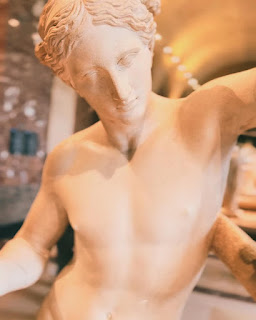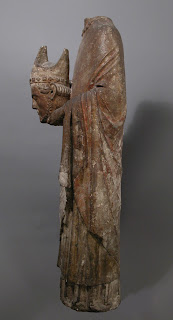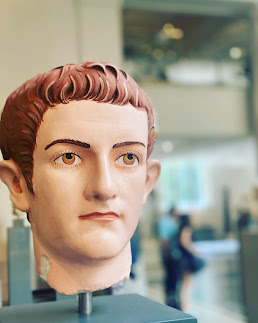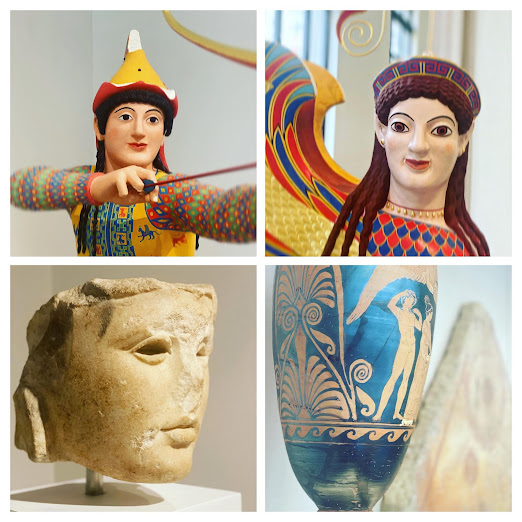Hi, I’m Greig — welcome! Here you’ll find sharp writing, creative ideas, and standout resources for teaching, thinking, making, and dreaming in the middle and high school ELA and Humanities classroom (Grades 6–12).
4.4.24
Zeus Ammon at the Met: A Greek-Egyptian Syncretism in Stone
 I am an educator and a writer. I was born in Louisiana and I now live in the Big Apple. My heart beats to the rhythm of "Ain't No Place to Pee on Mardi Gras Day". My style is of the hot sauce variety. I love philosophy sprinkles and a hot cup of café au lait.
I am an educator and a writer. I was born in Louisiana and I now live in the Big Apple. My heart beats to the rhythm of "Ain't No Place to Pee on Mardi Gras Day". My style is of the hot sauce variety. I love philosophy sprinkles and a hot cup of café au lait.
31.3.24
Alexander the Great's Portrait at British Museum: Deification & Legacy in Art
 I am an educator and a writer. I was born in Louisiana and I now live in the Big Apple. My heart beats to the rhythm of "Ain't No Place to Pee on Mardi Gras Day". My style is of the hot sauce variety. I love philosophy sprinkles and a hot cup of café au lait.
I am an educator and a writer. I was born in Louisiana and I now live in the Big Apple. My heart beats to the rhythm of "Ain't No Place to Pee on Mardi Gras Day". My style is of the hot sauce variety. I love philosophy sprinkles and a hot cup of café au lait.
20.3.24
Sully Wing Secrets: Louvre's Greek and Egyptian Wonders
Discover a teacher's unique Louvre encounters, from Greek beauty to Egyptian relics. Explore beyond Mona Lisa to uncover the Louvre's heart.
 |
| (2) Apollon Sauroctone |
 |
| (1) Éphèbe |
![Un fleuve Barye, Antoine Louis. Un fleuve. 19th century, France. Musée du Louvre, Department of Sculptures of the Middle Ages, Renaissance, and Modern Times, inventory number RF 1560 & RF 1561. Louvre Museum, Sully, [HIST LOUVRE] Salle 134 - Salle de la maquette, Vitrine 08](https://blogger.googleusercontent.com/img/b/R29vZ2xl/AVvXsEhRE9YnlXlK6KfP-A0z_dJZYnBT7_1M5T9D3tZk_gXozKs9gMd9nO9UXlkT5TkHi9T0KkSBwjL6qcfr74jTaMOtO6h47D1jJt4P6LadIo9MGzu3yL8o9KabJ2TLnGC05aMOJLGXy08A5kn4PeMuqb1xi3BchLe5z6tW_ddtYaAY0Te_gBcwPo7btQ/w180-h320/A65BC7E3-435F-4BF6-9AEE-992B60DCA921.jpg) |
| (3) Un fleuve |
![Statue of a Sphinx Musée du Louvre. Statue of a Sphinx. Circa 380-362 B.C. [?], Serapeum of Memphis, Saqqara. Musée du Louvre, Department of Egyptian Antiquities, Room 327, Sully, inventory number N 391 D. Louvre Museum](https://blogger.googleusercontent.com/img/b/R29vZ2xl/AVvXsEjgUwtk13qrP7vP1aawA_H8HLkuH_Om2fdXDUYZS5rp9gzDUj93w2JqthNzZp3HNWS8AsQqXaXeJC5UwcvtUI0RDp8NLgjTSiUTlm3d7iOqPGBZHf7o5BGbsuMqcyb0dXuT7bz1agggYfGBhFF45As03mepTGdzalqV6E6H9gy3r1oIJpCqEAcp_A/w256-h320/2B604D01-4603-465D-9A7E-BE621258F15E.jpg) |
| (4) Statue of a Sphinx |
![Statue Musée du Louvre. Statue. Third Intermediate Period, circa 1069-664 B.C. [?]. Musée du Louvre, Department of Egyptian Antiquities, inventory numbers E 2410; N 1579; Clot bey C 25 no. 5. Louvre Museum](https://blogger.googleusercontent.com/img/b/R29vZ2xl/AVvXsEjgbctrJI65LJI1iyrVOfQhyphenhyphene1Tc7QGTT4wcBmC08D_-9ItrigFHgGkqlDv2rPXfIA1CmP6V8ZIqsfUQ7CGr0K2fEwD4wjU7gBYdxKLbgTQEFFjb50Ge3hY9aGWehNd6EDdhxp35uN-0HYHIBL-vXWIXJD-NcecFiFCi6zVnQWKKJnMVmExZpZKfQ/w256-h320/75DFE6FB-8092-4AAD-8E84-5475A684CEDD.jpg) |
| (5) Statue |
![Jupiter Musée du Louvre. Jupiter. 2nd century A.D. [?], Italy. Musée du Louvre, Department of Greek, Etruscan, and Roman Antiquities, Room 344.](https://blogger.googleusercontent.com/img/b/R29vZ2xl/AVvXsEh9FIeOZBWXHqm5AryH2Cb0EdwkG_C2QX7rHPa3IQTeF_q7JBsmrEfeSbekVmJaSLsg_k0Zb9dCdUctsB_i8rQA2dVqXkSQoBwP9IxfPLOA-5B4ufz0bVSvIVbKjqkpQeJ2U2Gl6C53r3ylcqsay29L5YfAPJNU4zaHvj3boIWM6pv3BF-rpLhZqA/w256-h320/72D6CC7E-0683-4B1E-AA7E-FA3A9611BA85.jpg) |
| (6) Jupiter |
 I am an educator and a writer. I was born in Louisiana and I now live in the Big Apple. My heart beats to the rhythm of "Ain't No Place to Pee on Mardi Gras Day". My style is of the hot sauce variety. I love philosophy sprinkles and a hot cup of café au lait.
I am an educator and a writer. I was born in Louisiana and I now live in the Big Apple. My heart beats to the rhythm of "Ain't No Place to Pee on Mardi Gras Day". My style is of the hot sauce variety. I love philosophy sprinkles and a hot cup of café au lait.
10.3.24
Language Meets Art: Exploring 'Amor' and 'Caritas' in Augustus-Saint-Gaudens’ Work at The Met 🌟🖼️
Explore the captivating intersection of language and art in Augustus Saint-Gaudens' masterpiece, Amor and Caritas, at The Met. A linguistic and artistic journey awaits, unveiling the roots of love and charity in this gilt bronze treasure. Perfect for educators and art enthusiasts.
 I am an educator and a writer. I was born in Louisiana and I now live in the Big Apple. My heart beats to the rhythm of "Ain't No Place to Pee on Mardi Gras Day". My style is of the hot sauce variety. I love philosophy sprinkles and a hot cup of café au lait.
I am an educator and a writer. I was born in Louisiana and I now live in the Big Apple. My heart beats to the rhythm of "Ain't No Place to Pee on Mardi Gras Day". My style is of the hot sauce variety. I love philosophy sprinkles and a hot cup of café au lait.
1.3.24
Explore Greek & Roman Gods: Ares vs Mars - Mythology, Love, and War Insights
Dive into the fascinating world of Greek and Roman mythology with a detailed comparison between Ares and Mars. Discover their myths, lovers, and roles in ancient tales.
Hey, y’all. I’m in the Louvre Museum. Here stands Mars (or Ares to the Greeks), the deity of war, embodying cries, battles, bloodshed, and military conquest. It feels like the Romans admired him significantly, and although the Greeks certainly gave him a place of honor on Olympus, he wasn’t as much worshipped in temples as he was respected and feared. His lover was famously Aphrodite — the goddess of love. Also, in the spirit of exploring the less discussed side of history, we get to see his representation from behind. Additionally, if you’ve ever seen Ridley Scott’s ‘Prometheus’ — the prequel to the Alien movies — does the god’s face remind you of the giant humanoids from the film? And, if you’re a Percy Jackson fan, Ares plays a supporting role in the plot of the first book.
 I am an educator and a writer. I was born in Louisiana and I now live in the Big Apple. My heart beats to the rhythm of "Ain't No Place to Pee on Mardi Gras Day". My style is of the hot sauce variety. I love philosophy sprinkles and a hot cup of café au lait.
I am an educator and a writer. I was born in Louisiana and I now live in the Big Apple. My heart beats to the rhythm of "Ain't No Place to Pee on Mardi Gras Day". My style is of the hot sauce variety. I love philosophy sprinkles and a hot cup of café au lait.
27.7.23
Aesthetic Thursday: Encountering St. Firmin, the Ultimate Multitasker from the 4th Century, at the Metropolitan Museum of Art
 |
| Saint Firmin |
 I am an educator and a writer. I was born in Louisiana and I now live in the Big Apple. My heart beats to the rhythm of "Ain't No Place to Pee on Mardi Gras Day". My style is of the hot sauce variety. I love philosophy sprinkles and a hot cup of café au lait.
I am an educator and a writer. I was born in Louisiana and I now live in the Big Apple. My heart beats to the rhythm of "Ain't No Place to Pee on Mardi Gras Day". My style is of the hot sauce variety. I love philosophy sprinkles and a hot cup of café au lait.
12.7.23
Resurrecting Adam: Tullio Lombardo's Masterpiece Restored
 I am an educator and a writer. I was born in Louisiana and I now live in the Big Apple. My heart beats to the rhythm of "Ain't No Place to Pee on Mardi Gras Day". My style is of the hot sauce variety. I love philosophy sprinkles and a hot cup of café au lait.
I am an educator and a writer. I was born in Louisiana and I now live in the Big Apple. My heart beats to the rhythm of "Ain't No Place to Pee on Mardi Gras Day". My style is of the hot sauce variety. I love philosophy sprinkles and a hot cup of café au lait.
17.6.23
The Marble Maiden: Pygmalion, Galatea, and the Art of Love
In the sun-bathed island of Cyprus, a young artist named Pygmalion sought a beauty so perfect, so flawless, it could not be found in any living woman. Driven by an obsession of his ideal, Pygmalion turned to the marble blocks of his studio. His skilled hands chiseled the cold stone, shaping curves and contours until a woman of unearthly beauty emerged. She was so lifelike that one could swear she would move if spoken to. He named his creation Galatea, and against all odds, fell passionately in love with her.
As strange as it sounds, Pygmalion's tale is more than a story of love; it is a tale of artistic devotion, obsession, and the blurred lines between the creator and creation. And now, you have the opportunity to bring this intriguing Greek myth to your classroom, through an engaging and comprehensive resource I've crafted especially for middle and high school students.
 |
| Educational igital downloads like This One are Available from Stones of Erasmus. |
Introducing Pygmalion and Galatea: An Exploration of Myth and Art
This resource, offered as a PDF, Google Slides, and an Easel Activity and Assessment (exclusive to TpT), centers around the captivating narrative of Pygmalion and Galatea. With a three-day lesson plan complete with teachers' notes, it provides a structured, in-depth look at this myth, setting the geographical context with a map activity that situates the tale in the Mediterranean island of Cyprus.
Within this resource, reading cards offer two different versions of the Pygmalion and Galatea story, as well as an analysis of the myth through Clement of Alexandria's perspective. There are also art and literature connections which include a 16th-century artistic representation of the tale by Hendrick Goltzius, and a study of the myth's representation in various other forms of art.
To ensure your students' engagement, the resource offers a 14-count question bank for comprehension checks, and a custom note-taking template to encourage personal accountability. Frayer Model Vocabulary Cards offer students an effective way to visually understand the vocabulary related to the story. And just before wrapping up the class, a half-sheet exit ticket helps you gauge your students' understanding of the lesson.
Dig Deeper, Learn More
The learning doesn't stop here! I have included a further reading list, not just as a simple bibliography, but as a stepping stone to deeper exploration. By assigning different sources to students and organizing presentations, the learners can delve further into the story.
A unique aspect of this resource is the writing activity, which serves as a summative assessment. It asks students to analyze Pygmalion's character as either a "creator" or a "misogynist," stimulating thought-provoking discussions about gender, representation of women in literature and art, and more.
Answer keys are provided for all student-facing documents, giving you ample guidance on what to expect from students in their written and oral responses.
This resource can stand on its own, or can be paired with a larger unit on Graeco-Roman mythology or other popular texts like Ovid's Metamorphoses, Percy Jackson and the Lightning Thief, Robert Graves's Greek Myths, or Edith Hamilton's Mythology.
If you found this resource compelling, you might also be interested in other lessons included in the Middle and High School Mythology Series, such as Cupid and Psyche, Zeus and Metis & The Birth of Athena, Apollo and Daphne, and the ever-popular Plato's Cave lesson.
Come, join me on my journey as we breathe life into ancient myths. Visit Stones of Erasmus on the web and together, let us make learning an adventure. © 2023
 I am an educator and a writer. I was born in Louisiana and I now live in the Big Apple. My heart beats to the rhythm of "Ain't No Place to Pee on Mardi Gras Day". My style is of the hot sauce variety. I love philosophy sprinkles and a hot cup of café au lait.
I am an educator and a writer. I was born in Louisiana and I now live in the Big Apple. My heart beats to the rhythm of "Ain't No Place to Pee on Mardi Gras Day". My style is of the hot sauce variety. I love philosophy sprinkles and a hot cup of café au lait.
15.3.23
Clip Art: Endymion Sleeping on Mount Latmos
 I am an educator and a writer. I was born in Louisiana and I now live in the Big Apple. My heart beats to the rhythm of "Ain't No Place to Pee on Mardi Gras Day". My style is of the hot sauce variety. I love philosophy sprinkles and a hot cup of café au lait.
I am an educator and a writer. I was born in Louisiana and I now live in the Big Apple. My heart beats to the rhythm of "Ain't No Place to Pee on Mardi Gras Day". My style is of the hot sauce variety. I love philosophy sprinkles and a hot cup of café au lait.
14.7.22
Aesthetic Thursday: "You Got Color, Girl?" Chroma Exhibition at the Metropolitan Museum of Art
 |
| Greig poses in front of a young Marcus Aurelius in the Ancient Greek and Roman wing of the Metropolitan Museum of Art in New York City. |
 |
| Marble head of the youthful Marcus Aurelius ca. C.E. 138. |
But go to a museum today, and you see staid marble and what appears to be a vast collection of grays, browns, and three-dimensional black and white photographs. But the pigments and paints decay. And the weathering of the seasons and the march of time have made most color drain away.
But the coloration is still there, in small traces — which the Chroma exhibition at the Metropolitan Museum of Art has attempted to recapture — to see ancient artworks in color again. Alas, you won’t see the now lost statue of Zeus at Olympia, but you will see that same artist’s head of Athena, which at one time had ebony eyes. I especially liked the bronze warriors. And the Sphinx in color was fantastic.
If you have a moment and you are in New York — take a moment and experience these reconstructions done by Prof. Dr. V. Brinkmann & Dr. U. Koch-Brinkmann. @metmuseum @metgreekandroman
 |
| Reconstruction of a marble portrait of the Emperor Gaius Julius Caesar Augustus Germanicus, known as Caligula, Variant B. |
 | ||||
| [1] Reconstruction the bronze statue from the Quirinal in Rome of the so-called Terme Rule. [2] Reconstruction of bronze Riace Warrior (mid-view detail). |
 I am an educator and a writer. I was born in Louisiana and I now live in the Big Apple. My heart beats to the rhythm of "Ain't No Place to Pee on Mardi Gras Day". My style is of the hot sauce variety. I love philosophy sprinkles and a hot cup of café au lait.
I am an educator and a writer. I was born in Louisiana and I now live in the Big Apple. My heart beats to the rhythm of "Ain't No Place to Pee on Mardi Gras Day". My style is of the hot sauce variety. I love philosophy sprinkles and a hot cup of café au lait.
31.10.20
All Hallows' Eve in Greenwood Cemetery and Sunset Park, Brooklyn (Special 2020 Halloween Post)
In this post, I will regale you with pictures and musings from an All Hallows' Eve visit to Greenwood Cemetery and Sunset Park, Brooklyn. It was a beautiful Autumn Day and we are all cognizant of the need to physical-distance ourselves — so what better way to do that than to be outdoors in a massive cemetery?
Exploring Greenwood Cemetery on All Hallows’ Eve, I scored a handful of great photographs. Located in South Brooklyn, the cemetery is one of the oldest graveyards in the city and is a site of a Revolutionary War battle. @historicgreenwood is also a National Historic Landmark. My friends John and Jennifer joined me; we also went to Sunset Park, my old neighborhood. Scarfed down a torta stuffed with spicy pork at @tacoselbronco, scored a free beer from a passerby, and watched the D train come out of the tunnel on Fourth Avenue — it was a serendipitous day.


 I am an educator and a writer. I was born in Louisiana and I now live in the Big Apple. My heart beats to the rhythm of "Ain't No Place to Pee on Mardi Gras Day". My style is of the hot sauce variety. I love philosophy sprinkles and a hot cup of café au lait.
I am an educator and a writer. I was born in Louisiana and I now live in the Big Apple. My heart beats to the rhythm of "Ain't No Place to Pee on Mardi Gras Day". My style is of the hot sauce variety. I love philosophy sprinkles and a hot cup of café au lait.
4.5.19
Cycladic Sculptures Explained: Millennia-Old Faces of Aegean Art
 |
| In the Aegean Bronze Age section at the Metropolitan Museum of Art in New York City, you can find Cycladic art, famous for its abstract and stylized human figures, predominantly female, dating from around 2800 to 2300 BCE. |
 |
| An aerial, stylized view of the Aegean Sea, dotted with the Cyclades islands, nestled between Greece, Anatolia, and Crete. |
 I am an educator and a writer. I was born in Louisiana and I now live in the Big Apple. My heart beats to the rhythm of "Ain't No Place to Pee on Mardi Gras Day". My style is of the hot sauce variety. I love philosophy sprinkles and a hot cup of café au lait.
I am an educator and a writer. I was born in Louisiana and I now live in the Big Apple. My heart beats to the rhythm of "Ain't No Place to Pee on Mardi Gras Day". My style is of the hot sauce variety. I love philosophy sprinkles and a hot cup of café au lait.
1.4.16
"Air" by Walter Hancock - Sculpture along the Schuylkill River Trail
 I am an educator and a writer. I was born in Louisiana and I now live in the Big Apple. My heart beats to the rhythm of "Ain't No Place to Pee on Mardi Gras Day". My style is of the hot sauce variety. I love philosophy sprinkles and a hot cup of café au lait.
I am an educator and a writer. I was born in Louisiana and I now live in the Big Apple. My heart beats to the rhythm of "Ain't No Place to Pee on Mardi Gras Day". My style is of the hot sauce variety. I love philosophy sprinkles and a hot cup of café au lait.
17.6.14
Museum Review: Bacchus/Silenus Statuette from the Hill Collection (at the Frick)
A review of the Frick Collection's bronze statuettes collected by Janine and J. Tomilson Hill. |
| Attributed to Adriaen de Vries, Bacchus/Silenus, c.1579-80, bronze, 89.5 cm, private collection, USA, photograph by Maggie Nimkin.
Visited the Frick Collection on Sunday, the last day the museum exhibited bronze statuettes collected by Janine and J. Tomilson Hill. |
 I am an educator and a writer. I was born in Louisiana and I now live in the Big Apple. My heart beats to the rhythm of "Ain't No Place to Pee on Mardi Gras Day". My style is of the hot sauce variety. I love philosophy sprinkles and a hot cup of café au lait.
I am an educator and a writer. I was born in Louisiana and I now live in the Big Apple. My heart beats to the rhythm of "Ain't No Place to Pee on Mardi Gras Day". My style is of the hot sauce variety. I love philosophy sprinkles and a hot cup of café au lait.






